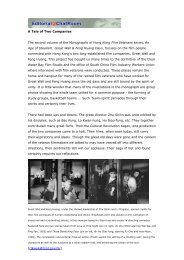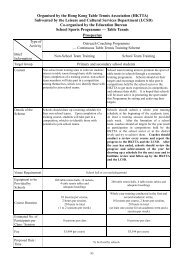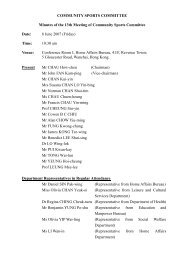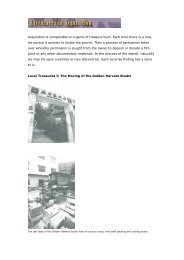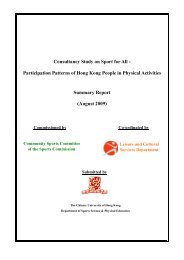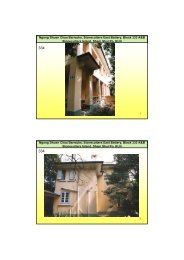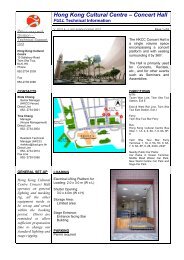Consultancy for Conservation Study of Chik Kwai Study Hall at Pat ...
Consultancy for Conservation Study of Chik Kwai Study Hall at Pat ...
Consultancy for Conservation Study of Chik Kwai Study Hall at Pat ...
Create successful ePaper yourself
Turn your PDF publications into a flip-book with our unique Google optimized e-Paper software.
longevity] (Fig. 144). On the rear eave wall is a mural flanked with two pieces <strong>of</strong> Chinese<br />
calligraphy (Fig. 145). The mural is depicting a scene <strong>of</strong> figures in a small hut and crossing a<br />
bridge in a landscape, enclosed by a white and red brocade-like border. The calligraphy on the left<br />
is a poem entitled furonglou song xinjian 芙蓉樓送辛漸 [At Hibiscus Inn Parting With Xin Jian]<br />
written by Wang Changling 王昌齡 (698-765). It reads,<br />
154<br />
Hanyu lianjiang yeruwu<br />
Pingming songke chushangu<br />
Luoyang qinyou ruxiangwen<br />
Yilpian bianxin zai yuhu<br />
寒雨連江夜入吳,<br />
平明送客楚山孤。<br />
洛陽親友如相問,<br />
一片冰心在玉壺。<br />
[Hiding the river, come into Wu in cold night-rain,<br />
In the dawn, I saw you to the mountains <strong>of</strong> Chu.<br />
If rel<strong>at</strong>ives and friends ask <strong>of</strong> me <strong>at</strong> Loyang,<br />
One-hearted as ice in a crystal vase.] 104<br />
Wang Changling 王昌齡 bade a farewell to his friend in the dawn after they came into Wu<br />
in a cold night. At th<strong>at</strong> moment, he was degraded to Guizhou 貴州 and expressed his feeling <strong>of</strong><br />
clean morality to his rel<strong>at</strong>ives and friends in Loyang. 105<br />
Below the purlins are murals along the friezes <strong>of</strong> the gable wall <strong>at</strong> the right side bay <strong>of</strong> the<br />
main hall. Below the ridge purlin is a mural entitled sanduo tu 三多圖 [Diagram <strong>of</strong> three<br />
abundances] expressing the wish <strong>for</strong> long life, every happiness and many sons (Fig. 146). To its left<br />
is another painting depicting a scene <strong>of</strong> idyllic landscape with a figure in a pavilion, which also has<br />
a border <strong>of</strong> white and red foli<strong>at</strong>e scrolls (Fig. 147). At the right side <strong>of</strong> the central mural are a piece<br />
<strong>of</strong> Chinese calligraphy and a painting (Fig. 148). The painting is depicting large peony blossoms<br />
among leaves <strong>at</strong>op a shoushi 壽石 [aged rock], together with two paradise flyc<strong>at</strong>chers,<br />
symbolizing changming fugui 長命富貴 [may you have wealth and longevity]. The calligraphy to<br />
104 At Hibiscus Inn Parting With Xin Jian, Wang Changling, Retrieved 27 February 2007, from Wengu, Website:<br />
http://www.afpc.asso.fr/wengu/wg/wengu.php?l=bienvenue.<br />
105 Zhu Jiongyuan 朱炯遠, Tangshi sanbaishou yizhuping 唐詩三百首譯注評 [The Transl<strong>at</strong>ion and criticism <strong>of</strong> 300<br />
Tang Dynasty Poetry], Shenyang 瀋陽, Liaooning guji chubanshe 遼寧古籍出版社, 1995, pp. 96-97.




